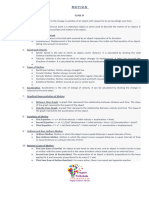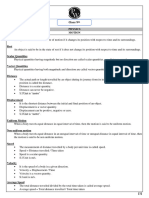0% found this document useful (0 votes)
31 views13 pagesMotion Class9 With Images
The document provides an overview of motion, defining it as the change in position of an object over time and detailing its types, including translatory, circular, rotational, and oscillatory motion. It explains key concepts such as distance versus displacement, speed versus velocity, and acceleration, along with relevant equations and graphs of motion. Additionally, it highlights applications of motion in various fields like transport systems and robotics.
Uploaded by
veer098709Copyright
© © All Rights Reserved
We take content rights seriously. If you suspect this is your content, claim it here.
Available Formats
Download as PPTX, PDF, TXT or read online on Scribd
0% found this document useful (0 votes)
31 views13 pagesMotion Class9 With Images
The document provides an overview of motion, defining it as the change in position of an object over time and detailing its types, including translatory, circular, rotational, and oscillatory motion. It explains key concepts such as distance versus displacement, speed versus velocity, and acceleration, along with relevant equations and graphs of motion. Additionally, it highlights applications of motion in various fields like transport systems and robotics.
Uploaded by
veer098709Copyright
© © All Rights Reserved
We take content rights seriously. If you suspect this is your content, claim it here.
Available Formats
Download as PPTX, PDF, TXT or read online on Scribd
/ 13

























































